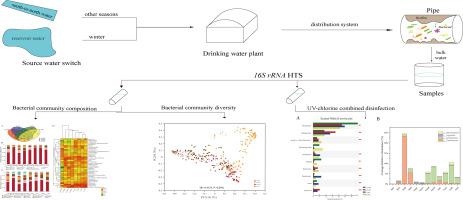Science of the Total Environment ( IF 9.8 ) Pub Date : 2021-02-20 , DOI: 10.1016/j.scitotenv.2021.145986 Zibo Jing , Zedong Lu , Ted Mao , Wenfeng Cao , Weibo Wang , Yanchu Ke , Zhinan Zhao , Xiaohui Wang , Wenjun Sun

|
The microbiological water quality of drinking water distribution systems (DWDSs) is of primary importance for public health. The detachment of biofilm attached on the pipe wall attribution to water source switch and the occurrence of potentially pathogenic chlorine-resistant bacteria (CRB) under chlorine disinfection get lots of attention. Studies examining microbial communities after the water source switch, particularly in low-salinity water, have been scant. The UV‑chlorine combined disinfection applied in one of the investigated drinking water plants provided insight into the control of CRBs. We applied high-throughput sequencing of the 16S rRNA gene to characterize the bacterial communities of the DWDS in northern China over 1 year. A network comprising four different DWDSs was sampled at 48 sites every season (temperate continental monsoon climate), and the impact of key spatial-temporal and physicochemical parameters was investigated. Overall, the entire bacterial community was not significantly different among the four DWDSs (spatial parameter) but varied with seasons (temporal parameter). The switch in water sources might increase the relative abundance of potentially opportunistic pathogens in DWDSs. UV‑chlorine combined disinfection can decrease community diversity and is likely to control the growth of potential opportunistic pathogens in DWDSs.


























 京公网安备 11010802027423号
京公网安备 11010802027423号